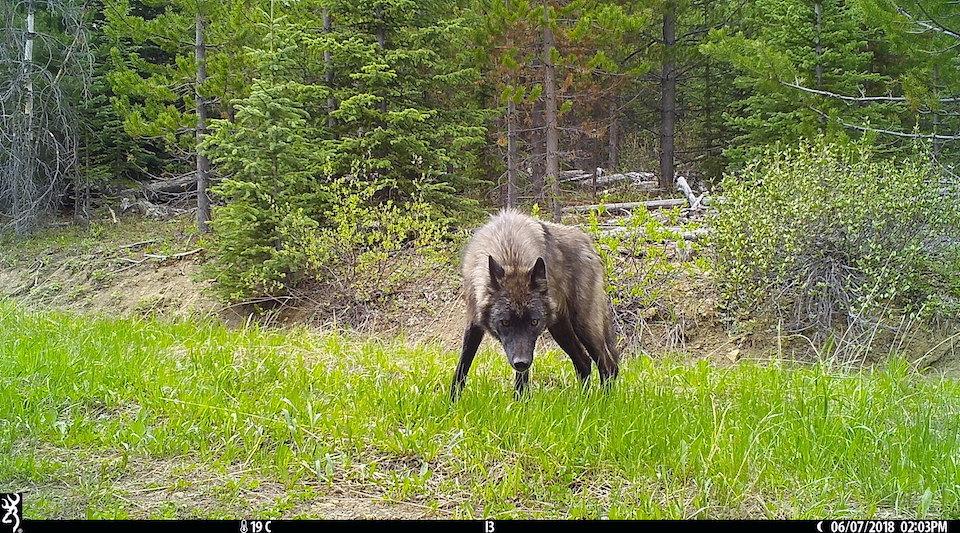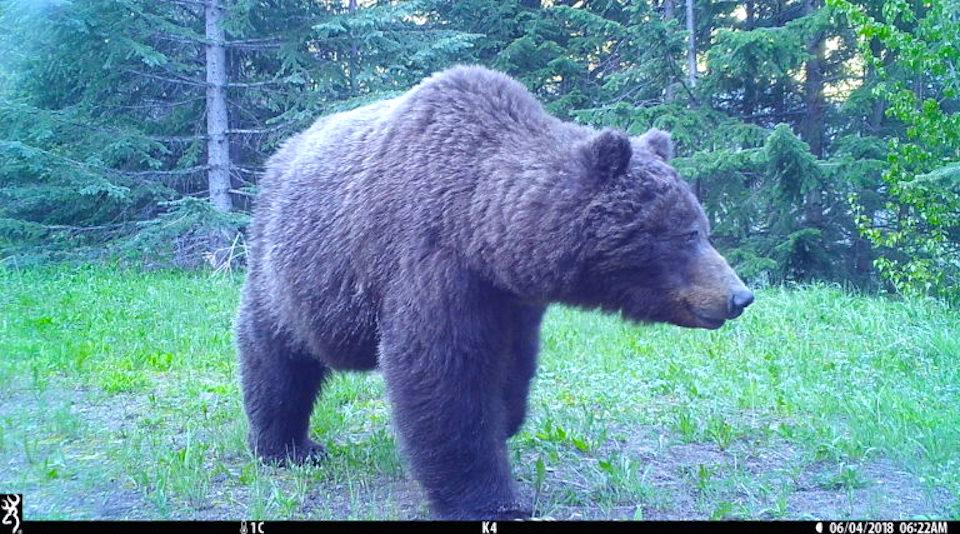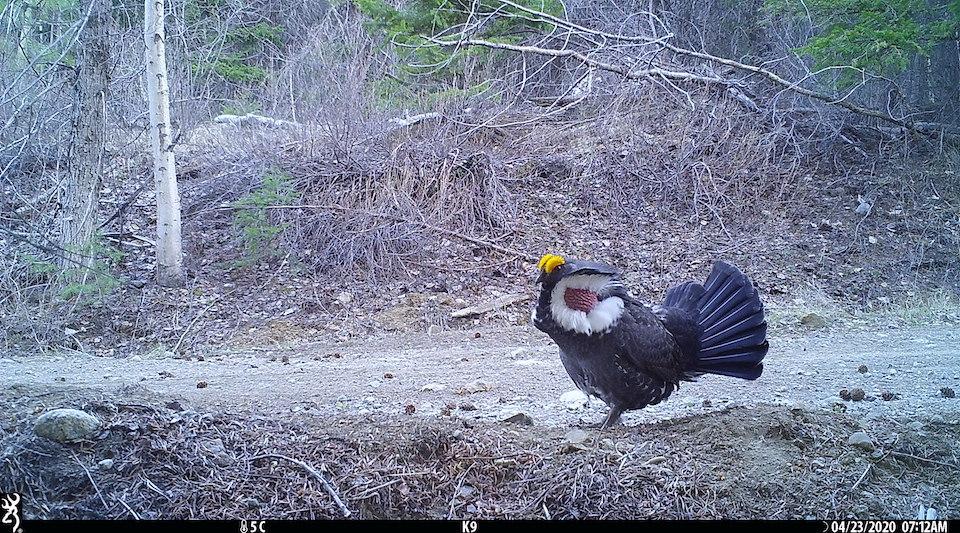
Canadian research reveals how wildlife react to different forms of recreation/Robin Naidoo
A Canadian study into how different forms of recreation affect wildlife indicates that animals avoid mountain bikers more than hikers, equestrians, and even motorized travelers. That said, the researchers also noted that they're not sure how far wildlife will go out of its way to avoid these recreational users, as their monitoring was restricted to established trails in South Chilcotin Mountains Provincial Park in southwestern British Columbia.
Additionally, they found that environmental factors -- such as the elevation or the condition of the forest around a camera location -- were generally more important than human activity in determining how often wildlife used the trails.
The researchers focused on 13 species, including grizzly bear, black bear, moose, mule deer, and wolf.
"We wanted to better understand the relative impacts of human recreation in this region, given its increasing popularity. We already know that motorized vehicle access can disrupt wildlife; our initial findings suggest that other types of recreation may also be having impacts," said study author Robin Naidoo, a University of British Columbia adjunct professor at the Institute for Resources, Environment and Sustainability.
The research was motivated in part by the greater use of the outdoors during the ongoing coronavirus pandemic. How, the researchers wondered going into their study, does recreational use affect natural systems, how much does it disturb wildlife, and does it lead to a degradation of biodiversity?
A press release from the University of British Columbia detailing the study said "(D)eeper analysis of trail use captured by the cameras showed that all wildlife tended to avoid places that were recently visited by recreational users. And they avoided mountain bikers and motorized vehicles (ATVs) significantly more than they did hikers and horseback riders."
The data were gathered through the use of 61 camera traps in the provincial park, which is "notable for its diversity of large wildlife species, including predators such as grizzly bear, wolverine, and fisher, as well as large ungulates such as moose, mule deer, and mountain goat." Combined, the cameras produced 6,285 days of activity. The most commonly spotted animals were mule deer, which appeared 4,070 times.

Sixty-one camera traps were used to monitor wildlife movements in relation to human recreation/Robin Naidoo
"Despite the diversity and abundance of wildlife captured on cameras, human activities were detected much more frequently," the researchers noted. "Mountain biking was the most commonly-recorded activity, with over twice as many detections (10,017) as mule deer. Hikers, motorized vehicles, and horseback riders all had higher numbers of detections than any wildlife species other than mule deer."
They concluded that hikers and horseback riders had the lowest impact on wildlife, while mountain biking and motorized travel had the greatest.
"While few recreational impacts were observed at the weekly time scale, our finer-scale analysis of wildlife displacement following human activity showed that all species of wildlife avoided all types of human recreational events on trails," the researches wrote. "This temporal avoidance by wildlife was highest for motorized vehicles and mountain biking, results that are consistent with studies documenting greater levels of wildlife disturbance associated with the noise and speed of motorized vehicles.
"They also suggest that wildlife in the study area may perceive mountain bikers more similarly to motorized vehicles than to nonmotorized recreation. The velocity at which mountain bikes travel along trails, as well as the tremendous growth of the activity, has led to concerns on their impact on wildlife, especially after high-profile incidences of conflict with grizzly bears."
What the research didn't reveal was to what degree "wildlife may be displaced from roads or trails by anthropogenic activities. As such, it was not possible to establish whether wildlife were avoiding large areas of habitat through which roads or trails run, or briefly moving off trails into adjacent habitat during times of human use."
Study co-author Cole Burton, a professor of forestry at UBC and the Canada Research Chair in terrestrial mammal conservation, says further research will be needed before any firm conclusions can be drawn.
"This is the first year of our multiyear study of the region. We'll continue to observe and to analyze, so that we can better understand and mitigate the effects of these different human activities on wildlife," said Burton. "Outdoor recreation and sustainable use of forest landscapes are important, but we need to balance them with potential disruption of the ecosystem and the loss of important species."
The study was published recently in Conservation Science and Practice. It received funding from Habitat Conservation Trust Fund, World Wildlife Fund, Lillooet Naturalists Society and BC Parks.

The study revolved around 13 wildlife species, including two species of grouse/Robin Naidoo

 Support Essential Coverage of Essential Places
Support Essential Coverage of Essential Places







Comments
What were they thinking??? Mountain biking and trail-building destroy wildlife habitat! Mountain biking is environmentally, socially, and medically destructive! There is no good reason to allow bicycles on any unpaved trail!
Bicycles should not be allowed in any natural area. They are inanimate objects and have no rights. There is also no right to mountain bike. That was settled in federal court in 1996: https://mjvande.info/mtb10.htm . It's dishonest of mountain bikers to say that they don't have access to trails closed to bikes. They have EXACTLY the same access as everyone else -- ON FOOT! Why isn't that good enough for mountain bikers? They are all capable of walking....
A favorite myth of mountain bikers is that mountain biking is no more harmful to wildlife, people, and the environment than hiking, and that science supports that view. Of course, it's not true. To settle the matter once and for all, I read all of the research they cited, and wrote a review of the research on mountain biking impacts (see https://mjvande.info/scb7.htm ). I found that of the seven studies they cited, (1) all were written by mountain bikers, and (2) in every case, the authors misinterpreted their own data, in order to come to the conclusion that they favored. They also studiously avoided mentioning another scientific study (Wisdom et al) which did not favor mountain biking, and came to the opposite conclusions.
Mountain bikers also love to build new trails - legally or illegally. Of course, trail-building destroys wildlife habitat - not just in the trail bed, but in a wide swath to both sides of the trail! E.g. grizzlies can hear a human from one mile away, and smell us from 5 miles away. Thus, a 10-mile trail represents 100 square miles of destroyed or degraded habitat, that animals are inhibited from using. Mountain biking, trail building, and trail maintenance all increase the number of people in the park, thereby preventing the animals' full use of their habitat. See https://mjvande.info/scb9.htm for details.
Mountain biking accelerates erosion, creates V-shaped ruts, kills small animals and plants on and next to the trail, drives wildlife and other trail users out of the area, and, worst of all, teaches kids that the rough treatment of nature is okay (it's NOT!). What's good about THAT?
To see exactly what harm mountain biking does to the land, watch this 5-minute video: http://vimeo.com/48784297.
In addition to all of this, it is extremely dangerous: https://mjvande.info/mtb_dangerous.htm .
For more information: https://mjvande.info/mtbfaq.htm .
The common thread among those who want more recreation in our parks is total ignorance about and disinterest in the wildlife whose homes these parks are. Yes, if humans are the only beings that matter, it is simply a conflict among humans (but even then, allowing bikes on trails harms the MAJORITY of park users -- hikers and equestrians -- who can no longer safely and peacefully enjoy their parks).
The parks aren't gymnasiums or racetracks or even human playgrounds. They are WILDLIFE HABITAT, which is precisely why they are attractive to humans. Activities such as mountain biking, that destroy habitat, violate the charter of the parks.
Even kayaking and rafting, which give humans access to the entirety of a water body, prevent the wildlife that live there from making full use of their habitat, and should not be allowed. Of course those who think that only humans matter won't understand what I am talking about -- an indication of the sad state of our culture and educational system.
Well, Mr. Vandeman, that's kind of what I had thought; but, Doug Schneider will certainly be very annoyed.